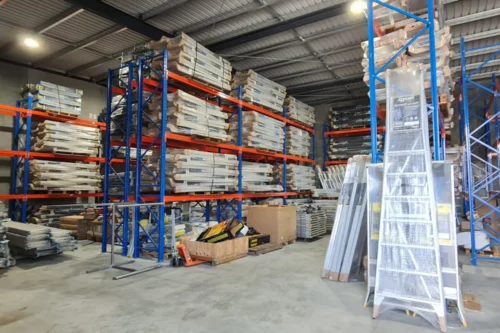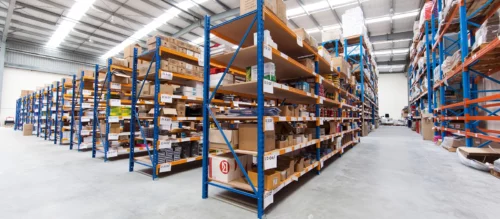Within the intricate workings of the supply chain, the warehouse emerges as a pivotal hub, where inventory management intertwines with operational precision. It serves as a focal point where strategic coordination becomes tangible, driving the seamless flow of goods and resources.
For logistics managers and supply chain professionals, mastering warehouse management isn’t just a cog in the wheel; it’s the very wheel that propels their business forward. In this discourse, we’ll unpack the essence of warehouse management, from its core definition to the more nuanced systems and best practices, offering a comprehensive guide for those navigating within the domain.
What is Warehouse Management?
Warehouse management, at its heart, is the art and science of controlling and managing the storage, movement, and handling of goods within a full warehouse space and the associated processes. It aims to enable efficient and cost-effective management of the warehouse, with an end goal of reaching the pinnacle of customer satisfaction through timely and defect-free delivery.
A poorly managed warehouse can often echo louder than the definition itself. From lost inventory that cost the company invaluable time and resources, to delayed shipments eroding customer trust, the implications of ineffective warehouse management can be negative.

Warehouse Management vs. Inventory Management
While the terms are often used interchangeably, warehouse management focuses on the ‘movement’ part of the goods, whereas inventory management is more about the ‘control’ aspect. Inventory management embodies the principles that guide how inventory is ordered, stored, and consumed.
To illustrate the difference in manual processes, we could narrate a common logistics manager’s day, where a successful shipment hinges on precise inventory management to ensure the stock is available while the warehouse management system is put to the test to execute the actual picking, packing, and shipping of the items.
Benefits of Effective Warehouse Management
A well-organized warehouse operates like a finely-tuned machine, characterized by structured processes, seamless workflows and improved inventory control.
Effective warehouse management transforms inventory control, enabling better tracking, forecasting, and management over stock levels. This precision reduces the likelihood of overstocking or understocking, which can be costly and detrimental to customer satisfaction.
Advanced WMS tools facilitate real-time inventory tracking, providing a clear visibility into current stock levels, demand forecasts, and supply chain workflows. By integrating predictive analytics, warehouse managers can make informed decisions, adjusting inventory levels to meet anticipated demand more accurately.
This not only minimizes holding costs by avoiding excessive stock but also ensures products are available when customers need them, enhancing service levels and reducing lost sales opportunities. In essence, meticulous warehouse management empowers businesses to maintain an optimal inventory balance, marrying efficiency with customer satisfaction.
Enhanced Efficiency and Productivity
Streamlined processes and optimised warehouse layouts play a pivotal role in increasing operational efficiency, essentially allowing workers to accomplish tasks with greater speed and precision. By meticulously designing the warehouse layout to minimise the distance between frequently accessed storage areas and loading docks, businesses can significantly reduce travel time for employees. This optimisation, when coupled with clear signage and easily navigable aisles, enables quicker retrieval and storage of goods, thereby enhancing the overall workflow.
Furthermore, streamlined warehouse processes, facilitated by automated systems can drastically reduce the likelihood of errors in picking and packing, ensuring that orders are fulfilled accurately the first time around.
Automation tools, such as barcode scanners and warehouse management software, help in verifying picks against orders in real-time, immediately flagging discrepancies and thus, minimising the chance of incorrect shipments. This synergy between a thoughtfully designed warehouse layout and streamlined processes not only boosts productivity but also elevates the accuracy of tasks performed, laying the groundwork for a significantly more efficient and error-resilient operation.
Cost Reduction
Efficient warehouse management directly contributes to significant cost savings by meticulously minimizing waste, curbing the necessity for surplus inventory, and optimizing worker productivity. Through implementing just-in-time (JIT) inventory management systems, warehouses can drastically reduce the resources squandered on storing excessive stock levels, which in turn diminishes storage costs and the risk of dated inventory.
This lean approach to inventory management focuses allows businesses to respond more agilely to demand fluctuations, ensuring that capital is not tied up in unnecessary stock. Additionally, by capitalizing on data analytics for precise demand forecasting, warehouses can further refine their inventory levels, reducing both overstock and stockouts and thus, lowering the costs associated with lost sales and expedited shipping.

Optimization of worker productivity plays a critical role in cost reduction as well. By utilising technology to automate routine tasks, warehouses can free up their workforce to focus on more complex operations that require human intervention, thereby enhancing overall efficiency.
Training programs dedicated to improving the skills of warehouse staff can lead to faster and more accurate completion of tasks, reducing the risk of errors that could lead to costly corrective actions. Efficient warehouse layouts that minimize the time and physical effort required to move goods from one point to another also contribute to increased worker efficiency, reducing operational costs in the process.
In summary, efficient warehouse management harnesses the power of technology, data analytics, and strategic operational planning to minimize waste, track inventory, optimize inventory and enhance worker productivity. These improvements collectively lead to substantial cost savings, ultimately contributing to the lean operation and financial health of the business.
Better Customer Service
Improved inventory control and heightened warehouse efficiency can directly lead to faster order fulfilment and a marked increase in the accuracy of orders. This streamlined approach ensures that products are not only promptly dispatched but are also in line with what customers have requested, significantly reducing the chances of errors and returns.

Speedy and accurate deliveries are critical in building trust and reliability in the eyes of consumers, setting the foundation for a positive customer experience. When customers receive their orders on time and as expected, their satisfaction levels soar, fostering loyalty and encouraging repeat business.
In essence, the meticulous management of warehouse operations and inventory, by ensuring the swift and accurate processing of orders, plays a crucial role in enhancing customer satisfaction and driving the success of the business.
Increased Flexibility and Scalability
An effectively managed warehouse possesses the remarkable ability to adapt seamlessly to fluctuations in demand, changes in inventory levels, and the natural evolution of business growth, all without undergoing significant disruptions.

This adaptability is crucial in today’s fast-paced market environment, where demand can be unpredictable and business operations must remain agile to thrive. A key aspect of achieving this flexibility lies in the utilisation of advanced data analytics and forecasting tools, which enable warehouse managers to anticipate changes and adjust their operations accordingly.
By maintaining a well-organised and efficient warehouse, businesses are better positioned to scale their operations up or down in response to market demands, ensuring that they can meet customer needs without unnecessary delay or expense. This scalability not only supports business sustainability but also strengthens the company’s competitive edge in the marketplace.
Enhanced Security and Safety
Proper warehouse management extends well beyond efficiency and productivity; it encompasses rigorous measures to bolster the security of goods and guarantee the safety of all employees.
Through the implementation of state-of-the-art security systems, including surveillance cameras and access control mechanisms, warehouses can deter theft and unauthorized access, ensuring the integrity of stored goods. Inventory management software technologies play a pivotal role in tracking stock movements, further safeguarding against loss or misplacement.
Equally important is the commitment to employee safety, a fundamental aspect of warehouse operations. This involves regular safety trainings, the enforcement of safety protocols, and the provision of appropriate personal protective equipment (PPE). By maintaining a clean and well-organized environment, management can significantly minimize the risk of accidents, such as slips, trips, or falls. Furthermore, investing in ergonomic equipment and tools not only supports the health and well-being of employees but also enhances productivity by reducing the likelihood of injury-related downtime.
Thus, effective warehouse management is instrumental in creating a secure and safe working environment, pivotal for protecting assets and ensuring the well-being of employees, which in turn, minimizes potential financial losses related to accidents or theft.
Data-Driven Decision Making
In the realm of warehouse management, the utilisation of sophisticated warehouse management systems (WMS) is pivotal for harnessing the power of data and analytics. These systems collect comprehensive data regarding every facet of warehouse operations, from inventory levels and shelf life of products to worker productivity rates.
Through sophisticated data analysis, WMS provide valuable insights that inform strategic decision-making. For instance, by evaluating patterns in inventory movement and demand forecasts, businesses can optimise their stock levels, reducing the risk of overstock or stockouts.

Additionally, data on staff performance and operational bottlenecks allow managers to identify areas where training or process improvements are needed. This capability to make data-driven decisions greatly enhances operational efficiency, reduces costs, and improves overall customer satisfaction. Essentially, the analytics offered by WMS act as a roadmap for continuous improvement and strategic planning within the warehouse, ensuring that operations are not just reactive, but proactive and strategically aligned with business goals.
These operational benefits translate into tangible experiences where an efficient warehouse can make the critical difference between a happy, loyal customer, and one who is won over by the competition’s faster service.
The Role of a Warehouse Management System (WMS)
Modern complexities in warehousing have given rise to the Warehouse Management System (WMS). It is the digital brain of the warehouse, coordinating and optimizing operations including the inventory management system, and order fulfillment, picking, packing, and shipping.
Implementing a WMS marks a paradigm shift akin to adopting advanced technology over antiquated methods. It brings clarity and efficiency to processes that were previously obscured.
The advantages of employing a Warehouse Management System (WMS) extend far beyond mere organisation. Firstly, it significantly boosts efficiency and productivity by automating routine tasks, thereby allowing staff to focus on more complex operations. Equally, a WMS enhances accuracy within the warehouse, minimising errors in order fulfilment and inventory records that can otherwise lead to costly corrective actions.
On the sustainability front, it promotes environmentally friendly practices by optimising storage space and reducing waste, proving that technology cannot only drive business success but also contribute to a greener planet. Lastly, by using key performance indicators providing real-time data and analytics, a WMS offers invaluable insights for decision-making, ensuring that warehouse operations are not just reactive but strategically aligned with broader business objectives.
Examples of warehouse management software
Warehouse management systems (WMS) are crucial tools for optimizing warehouse operations, ensuring efficient inventory control, and enhancing overall supply chain management. Among the top-rated WMS solutions for 2024, NetSuite WMS stands out for its comprehensive features that support a full, warehouse management solution that encompasses a wide range of warehouse activities.
Core Components of Warehouse Management
In the intricate world of warehouse management, several core functions stand distinguished. These range from the meticulous art of inventory control, where managing stock levels artistically balances the fine line between too much and too little, to the strategic labor management, transforming the workforce into an efficiently choreographed ensemble.
Shipping and Receiving acts as the overture — the initial anticipation before the orchestration even begins, where safety and maintenance play the critical role of maintaining the harmony and the very lifeblood of operations, ensuring both people and property remain protected.
Inventory Control
Effective inventory control is the keystone to maintaining the precarious balance between overstocking and stockouts. One widely hailed technique is the Just-In-Time (JIT) inventory system, which aims to have materials arrive exactly when they are needed in the production process, thereby reducing the costs associated with holding stock. However, the implementation of JIT requires precise forecasting and excellent coordination with suppliers, as any delay can halt the entire production line.

Labour Management
Labour management within the warehouse context goes beyond mere task allocation; it involves harnessing the collective efforts of the workforce towards optimal productivity and efficiency. Key strategies include implementing flexible working hours to accommodate peak times, utilising technology for task automation, and encouraging continuous training and development.
Shipping and Receiving
At the heart of warehouse dynamics, the processes of shipping and receiving are pivotal. They form the bedrock upon which the reputation of a business either blossoms or withers. Shipping efficiency reflects directly on customer satisfaction and loyalty, as timely and accurate delivery of goods is a primary expectation of any service. On the flip side, the receiving process is integral to maintaining the integrity of the warehouse’s inventory.

It is the initial checkpoint for quality control, ensuring that goods received match the purchase orders and are free from damage. An effective shipping and receiving system not only prevents bottlenecks that could slow down operations but also serves as a defence against inventory discrepancies, and inventory turnover ultimately safeguarding the business’s bottom line.
Safety and Maintenance
The paramount importance of safety within the warehouse cannot be overstated. It lays the foundation for a secure environment where operations can flourish without the looming threat of accidents and injuries. A steadfast commitment to safety protocols not only protects the workforce but also preserves the integrity of the warehouse manager who oversees goods and equipment housed within.
Regular safety audits and adherence to stringent safety regulations are indispensable, serving to identify potential hazards before they burgeon into serious issues.

Furthermore, equipping staff with appropriate safety training empowers them to recognise and mitigate risks autonomously, fostering a culture of safety that permeates every level of the warehouse operation. In essence, prioritising safety is not merely about compliance or avoidance of financial liabilities; it is about creating a resilient operational backbone that supports sustained productivity and ensures the wellbeing of everyone involved.
Best Practices and Technological Advancements
Harvesting the yield of effective warehouse management demands a commitment to operational best practices. These are the guiding stars in the nightly sky of warehouse management tools and operations, steering decisions, and frameworks towards successful and replicable outcomes.
Technology, on the other hand, is the rocket fuel burning fiercely beneath the warehouse’s regulatory framework. The advancements in machine learning, robotics, and IoT are revolutionizing traditional warehouses into smart, efficient hubs, as warehouses evolve in concert with the supply chain.
The Physical Composition of a Warehouse
The design and layout of a warehouse play a critical role in determining the efficiency of operations and the overall productivity of the logistical processes. An optimally designed warehouse maximizes the use of space, allowing for the smooth flow of goods in and out of the facility. This includes thoughtful placement of racks, aisles, and shipping/receiving areas to minimise travel time and reduce bottlenecks.
Efficient layout planning also considers the type of goods stored, their turnover rates, storage locations, and the need for special storage conditions. By aligning the physical structure of the warehouse with the unique demands of the operation, businesses can significantly enhance throughput, reduce operational costs, and improve worker safety.
In essence, thoughtful warehouse design is not just about space utilization; it’s about creating a system where resources, be it human or capital, are employed to their maximum potential for the highest operational efficiency.
Preparing for the Future
The future of warehouse management is not distant; it’s an ongoing evolution shaped by present actions. Emerging trends such as automation, artificial intelligence, and sustainable practices are already reshaping the landscape of the industry. Forward-thinking businesses have a significant opportunity to incorporate these changes, as evidenced by successful industry examples. Proactive preparation is essential for ensuring that customers receive exceptional service and experiences. By anticipating and adapting to emerging trends, businesses can orchestrate seamless operations that leave a lasting impression on their audience.
Conclusion
Warehouse management transcends the mere storage of goods. It is a complex ballet of storage, systems, and strategies that have a profound impact on a business’s bottom line. By understanding, implementing, and optimizing warehouse management processes, companies can ensure their position at the forefront of a dynamic and competitive market.
In the quest for mastery, there is no silver bullet, only a continuous refining of actions, leveraging tools and technologies, and heeding the signs of an evolving industry. The takeaway from this deep-dive into warehouse management is not just profound knowledge, but the foundations to build upon, the pillars to reinforce, and the spirit to surmount the challenges that every warehouse faces.
To explore deeper or share your own thoughts on the matter, we invite you to join the conversation. Connect with like-minded professionals, weigh in with your own experiences, or consider seeking advice tailored to your unique challenges.
It is through this collective knowledge that the art of warehouse management transcends to become the very backbone of the supply chain — strong, agile, and unyielding in the face of modern business dynamics.
